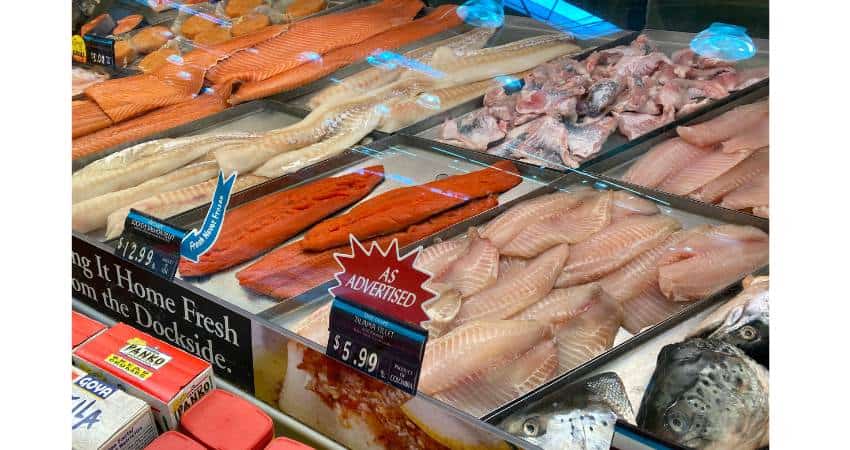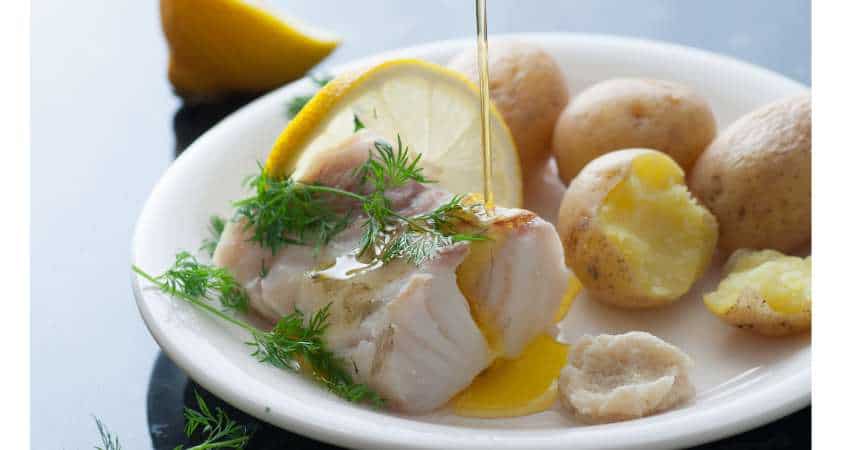Atlantic Pollock vs Cod – Is One Better? Let’s Compare
Atlantic Pollock is part of the same family as cod. They’re both popular making it sometimes difficult to choose between the two. Therefore, is cod fish better than Atlantic Pollock?
Atlantic Pollock is better than cod due to its higher percentage of heart healthy omega-3 fatty acids, B vitamins and minerals. Atlantic Pollock contains more B6, B12, B5, B2, B3, iron, magnesium and calcium. Atlantic Pollock is more flavorful due to its oily, healthy fat content.
This article will examine all the differences between the two fish including a side-by-side nutrient comparison. In addition, I’ll compare their tastes, textures, cooking methods, mercury levels and whether one can substitute for the other.
As a Certified Health Coach, many of my clients ask me about seafood. In addition to coaching clients about pollock and cod, I’ve purchased, researched and consumed both fish for over 20 years.
Atlantic Pollock vs Cod: Tastes and Textures
Tastes
Let’s face it, a huge decision when deciding between two fish to eat, is their tastes. Therefore, let’s determine which one tastes better.
Atlantic Pollock is more flavorful than cod due to its oily, fat content. Both fish are mild tasting and non-fishy. Cod is a little more sweeter tasting than Pollock.
Cod also has a mild to sweet flavor. It is good for people who want to avoid a fishy tasting seafood or strong taste.
The difference between the tastes of the two fish is not large, and most people wouldn’t consider them to be much different. A side-by-side taste test may be necessary to pick out the difference, so that’s what I did.
I set up a blind taste test at my home. Both fish were seasoned and cooked the same way. Of the four people involved, three chose the pollock.
I conducted more original research on taste by polling my health coaching clients, people signed up to my newsletters and members of food groups I belong to. I asked them, Atlantic Pollock vs cod, which one tastes better?
- 54% said they preferred the pollock and it was a good fish to eat.
- 46% said they preferred the cod.
Textures
What’s the difference between Atlantic Pollock and cod’s textures? Cod is firmer than Atlantic pollock’s tender to firm texture. The firmer texture holds together better when grilling or searing. A cod fillet is thicker than Atlantic Pollock and has larger flakes.
A properly cooked cod is flaky, firm and moist. Cod is a firmer fish than pollock. The Pacific cods have more moisture to them than Atlantic cods. Their fillets have large flakes and are thicker than many others.
Pollock has medium sized flakes and is tender but slightly firm. Their fillets are a little thinner with smaller flakes.
Substitutes
Sometimes you won’t have the exact fish for a recipe, or the seafood section of the supermarket doesn’t have the fish you need. Especially Pollock which is more difficult to find. Therefore, let’s examine if you can substitute one fish for the other.
Cod can substitute for Atlantic Pollock due to their similar milder tastes although the textures are sightly different. Substituting cod increases the methods of cooking including grilling due to it’s firmer texture. Both fish can be fried, baked, broiled or poached.
Other popular uses are fish fingers and crumbled fish.
Atlantic Pollock can substitute for cod due to their similar mild to sweet tastes. Pollock can be used for many of the same cooking methods like frying, poaching, broiling and baking.
Good substitutes for cod or similar fish include:
- Pollock
- Haddock
- Halibut
- Striped bass
- Tilapia
- Mahi mahi
Good substitutions for Pollock include the following:
- Halibut
- Tilapia
- Branzino
- Cod
- Rainbow trout
- Butterfish
- Hake
Tastes may matter more than texture when substituting but you may choose a certain fish if a certain cooking method has to be used.
When substituting either fish try to stick to the following:
- Same size and weight.
- Stick with similar fillets, whole fillet or cross section.
- Stick with skinless or skin when the recipe calls for one.
- Texture is more important for certain fish cooking methods. Like using a firmer texture when grilling1.
The Cost of Atlantic Pollock and Cod Fish
The cost of either fish will differ depending on the water fish came from, fresh or frozen and whether it’s farm raised or wild caught.
Cod fish cost more than Atlantic Pollock. The average cost for wild caught cod is $14.99 per pound while the average cost for wild caught Atlantic Pollock is $9.86 per pound.
I conducted research on costs by visiting various stores and checking their prices.
First, I checked Freshdirect for the current prices. I was only able to find one of the two fish.
- Fresh, wild caught cod fish
- $16.99 per pound
I checked the local Shopright supermarket, in store and online, and found the following fish prices. I was unable to find Pollock.
- Fresh wild caught Alaska cod fillet
- $8.99 per pound
- Fresh wild North Atlantic cod fillet
- $12.99 per pound
I checked Fulton Fish Market online and found the following prices:
- Fresh, wild Pollock (Atlantic)
- $9.72 per pound
- Fresh, wild Atlantic cod
- $19.50 per pound
I checked Reds Best online and found the following price for Pollock:
- Fresh, wild pollock (Atlantic)
- $10.00 per pound
The availability of Pollock will be more difficult to find in your local supermarket. You’d have a better chance finding it in a fish market or online.
Atlantic Pollock is cheap compared to other fish due to its availability. The Gulf of Maine population is above target levels and the fish is not over fished. Although in 2021 they are becoming more scarce and the price is increasing.

Atlantic Pollock vs Cod: Habitats, Size, Weight, Appearance
Let’s take a detailed look at the differences between the two fish.
Atlantic Pollock and cod are both from the Gadidae family but are different species. Pollock are longer and weigh more. Atlantic Pollock’s color is brownish-green while cod its more brownish. Both fish are found in the Northwest Atlantic Ocean, but cod are also in the Pacific Ocean.
Pollock is sometimes used as scrod. If you’re interested in learning about scrod fish, check out my article about it, Scrod: There’s More To The Story.
Popular Scientific Classifications, Species (Alaska Pollock)
- Atlantic Pollock are from the Gadidae family, Pollachius genus and Pollachius Pollachius species2.
- Cod are from the Gadidae family, Gadus genus and species are morhua (Atlantic cod), macrocephalus (Pacific cod) and ogac (Greenland cod).
Alaska Pollock are from the same family but are a different genus and species. I wrote an article comparing the differences with Alaska Pollock if you’re interested.
Habitats
Atlantic Pollock are found in the Northwest Atlantic Ocean. They are most commonly found swimming on the western Scotian Shelf and in the Gulf of Maine.
Atlantic cod is found in the Northwest Atlantic Ocean from Greenland to North Carolina and in the western Gulf of Maine. The Pacific profile and species is found in the North Pacific Ocean from the Bering Sea to California in the east and to the Sea of Japan in the west.

Colors
- Atlantic Pollock are brownish-green on the back and slightly pale on the belly. The fish have a lighter lateral line running down the body.
- Cod is brownish with dark spots with a cream lateral line running down the body.
Appearance
- Both fish have the typical long, narrow body shape and have three dorsal fins.
Size and Weight
- Atlantic Pollock grows to 42″ in length and weighs up to 27 pounds.
- Cod grows an average 27-34″ in length and weighs 5-15 pounds.
Age
- Atlantic Pollock live up to 23 years.
- Cod up to 12 years.
Atlantic Pollock and Cod Nutrition Comparison
The table below lists the nutrients for each fish per four ounces.
| Nutrient | Cod, raw (4 Ounces) | Atlantic Pollock, raw (4 Ounces) |
| Calories | 93 | 104 |
| Fat | 0.8 g | 1.1 g |
| Saturated Fat | 0.1 g | 0.2 g |
| Cholesterol | 49 mg | 81 mg |
| Protein | 23 g | 22 g |
| Omega-3 | 0.22 g | 0.50 g |
| B-6 | 0.2 mg | 0.3 mg |
| B-12 | 1.0 mcg | 3.6 mcg |
| Thiamin | 0.08 mg | 0.05 mg |
| Riboflavin | 0.07 mg | 0.21 mg |
| B5 | 0.1 mg | 0.4 mg |
| Iron | 0.4 mg | 0.5 mg |
| Niacin | 2.3 mg | 3.7 mg |
| Folate | 7.9 mcg | 3.4 mcg |
| Potassium | 468 mg | 403 mg |
| Magnesium | 36 mg | 75 mg |
| Phosphorus | 230 mg | 250 mg |
| Calcium | 18.1 mg | 68.0 mg |
| Zinc | 0.5 mg | 0.5 mg |
| Selenium | 37.5 mcg | 41.4 mcg |
Fish Nutrient Sources ((Nutrition Value: Fish, raw, Atlantic, cod)) ((Nutrition Value: Fish, raw, Atlantic, pollock))
Both fish contain a wide variety of similar nutrients. Cod contains more of some while pollock contains more of others. Let’s examine which of the two fish is healthier.
Atlantic Pollock is healthier than cod due to its 120% more heart healthy omega-3 fatty acids. It also contains more B vitamins and minerals than cod. Atlantic Pollock provides a higher percentage of B6, B12, riboflavin, B5, iron, niacin, magnesium, phosphorus, calcium and selenium.
It’s surprising because most people would have guessed cod. For good reason due to cod’s high nutritional value and the popular use of cod liver. It contains more thiamin, folate and potassium.
Consuming each fish is healthy and you can’t go wrong with the vitamins and minerals provided by both fish.
The protein between pollock and cod is almost equal.
Atlantic Pollock and Cod Health Benefits
Omega-3 Fatty Acids
Atlantic Pollock provides over double the number of omega-3 fatty acids. Omega-3 fatty acids are heart healthy and help keep arteries healthy. One way they accomplish this is by keeping bad cholesterol low and good cholesterol high.
Two of the fatty acids, DHA and EPA are associated with lowering blood pressure and improving the health of blood vessels ((National Center for Biotechnology: Marine Omega-3 Supplementation and Cardiovascular Disease)).
In addition, they help keep the blood vessels healthy by reducing inflammation, plaque build-up, triglycerides and can help keep the heart rhythms more normal.
Studies suggest omega-3s in fish can help reduce joint pain and stiffness in people with rheumatoid arthritis. They may also boost the effectiveness of anti-inflammatory drugs.
I recently wrote an article comparing black cod to cod. If you’re interested in how many omega-3s the fish contains or just want to learn about it, check out my article, Black Cod vs Cod – Is There A Difference?

Magnesium
Pollock provides double the magnesium. Adding magnesium to your diet could be instrumental in improving sleep quality. More so, it helps keep blood pressure levels balanced and stable ((National Institutes of Health: Magnesium)).
Magnesium relaxes and calms the whole body including the blood vessels. A recent study researched 22 studies and concluded magnesium supplementation decreased systolic and diastolic blood pressure3.
B Vitamins
Both fish contain many B vitamins, although pollock provides a higher percentage. These include B6, B12, B5, B1 (thiamin), B2 (riboflavin), B3 (niacin) and B9 (folate). B vitamins help support the following:
- Digestion
- Red blood cells
- Brain function
- Energy levels
- Nerve function
- Cardiovascular health
Calcium
Pollock provides over three times the amount of calcium. Calcium, like magnesium is important for blood pressure and the heart.
Harvard Health reports calcium helps maintain blood pressure because it helps to control the relaxing and tightening of blood vessels4.
Selenium
Both fish contain good amounts of selenium although Pollock a little more. Studies5 show selenium may help to protect the following:
- Immune system
- Heart disease
- Cognitive issues
- Thyroid health
Potassium
Both fish contain a good amount of potassium, cod a little more. Potassium is beneficial for reducing sodium intake. It helps the body reduce fluids and rids excess sodium ((American Heart Association: How Potassium Can Help Control High Blood Pressure)). This process helps to reduce blood pressure.
Mercury Levels
The FDA and the EPA have warnings and suggestions regarding mercury levels in fish and how often to consume them6. This is especially important for pregnant women, breastfeeding or for young toddlers and infants.
They established a list of best choices, good choices and fish to avoid based on their mercury levels.
Atlantic Pollock and cod contain similar mercury levels. Cod and pollock are listed on the FDA’s best choices in regards to mercury levels.
Always check with a physician prior to eating new fish, foods, Pollock, cod, changing your dietary habits and how often to consume certain fish.

Reply or Contact
If you have any questions about this fish article, facts or pollock, don’t hesitate to email and notify us. You can find an email on our contact page. We’ll do our best to reply as soon as possible.
Read Next – More Cod vs Fish Articles!
Haddock vs Cod: Is One Better? A Complete Comparison
Flounder vs Cod: Is One Better? Let’s Compare
Blue Cod vs Cod – A Complete Comparison
Halibut vs Cod: The Differences In Detail
- Sea Grant North Carolina: Fish Flavors and Substitutions [↩]
- Britannica: Pollock [↩]
- National Center for Biotechnology Information: Effect of magnesium supplementation on blood pressure: a meta-analysis [↩]
- Harvard Health: Key minerals to help control blood pressure [↩]
- National Institutes of Health: Selenium [↩]
- FDA: Advice about Eating Fish [↩]
